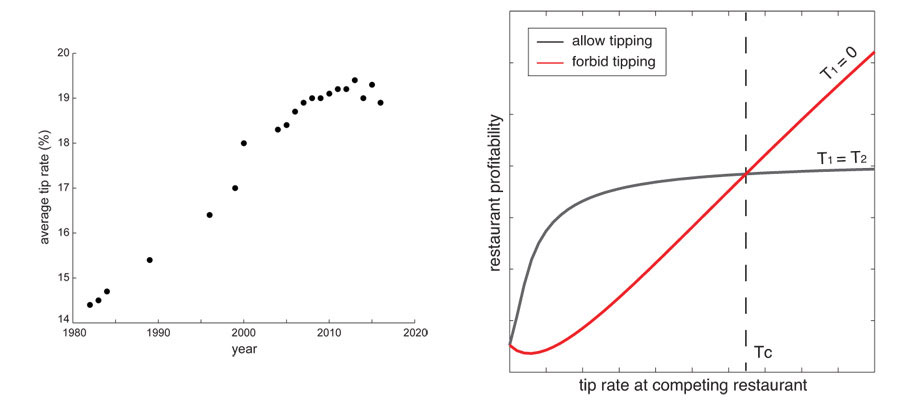Nonlinear dynamic model reveals the hidden profit motive behind abandoning tipping and looks to predict if -- and when -- restaurants will ditch tipping altogether.
From the Journal: Chaos
WASHINGTON, D.C., February 27, 2018 — The average rate at which Americans tip for services has been increasing steadily for decades, which creates a growing pay disparity between tipped and nontipped workers. The practice has been branded over the years as classist, anti-egalitarian, and downright undemocratic, leading some restaurateurs to abandon it. A new paper, drawing insight from nonlinear dynamics, hopes to shed light on the economically irrational world of tipping, showing that at a certain point, banning the practice might be fair and profitable.
A team of researchers presented a model that describes the dynamical nonlinear system that captures the relationships among tipped restaurant workers, nontipped ones and customers as restaurant owners change their tipping policies. As reported recently in the journal Chaos, from AIP Publishing the researchers used a dynamical systems approach and numerical modeling to find that, at certain tip rates, a rational restaurant owner would be wise to reel in how much customers can tip and perhaps to ban it altogether.
“Tipping has always been a super controversial topic, and it’s been an especially hot topic in the news lately,” said Sara Clifton, study author at University of Illinois at Urbana-Champaign. “I was shocked that such a simple model could replicate what we see qualitatively in the real world.”
Clifton and her colleagues employed a social group competition model. This approach has been used to describe anything from declines in religious affiliation to the prevalence of left-handedness. Hypothetical restaurants were defined as social groups in which servers, cooks and customers interacted. As hypothetical management decisions were made, the social groups adapted dynamically until equilibrating.
Cooks, for example, prefer to work in restaurants with higher wages. A bump in food quality brings in more customers, who are weighing both the food and the service. This causes the demand to be a server to rise, so long as the wages and tipping policies are friendly for wait staff. If cooks’ pay is prioritized over that of waiters, customers might become turned off by the poor service.
Global sensitivity and uncertainty analysis using techniques called Latin Hypercube Sampling and Partial Rank Correlation Coefficients revealed that equilibrium distributions of diners and servers depend significantly on tip rates and employee pay.
As tipping rates rise, the team’s model predicts we will approach a critical threshold at which it’s more profitable for restaurateurs to abandon tipping in their eateries.

Where this threshold occurs depends on a variety of factors, including menu prices and the diner-to-server ratio. Clifton reports that the model reflects real-world restaurants. For example, she points to the dearth of tipping in fast food restaurants and recent high-profile attempts to abandon tipping, only for it to be later reinstated.
“Ultimately, it’s diners that collectively decide the critical tip rate,” Clifton said. “Diners are making the most complicated decisions in the system.”
While her current model only predicts the ending of tipping as tipping rates increase, Clifton said she hopes future work and access to reliable data will allow her to deliver answers on how restaurant owners should deal with this hot-button topic.
###
For More Information:
Julia Majors
media@aip.org
301-209-3090
@AIPPhysicsNews
Article Title
The tipping point: A mathematical model for the profit-driven abandonment of restaurant tipping
Authors
Sara M. Clifton, Eileen Herbers, Jack Chen and Daniel M. Abrams
Author Affiliations
University of Illinois at Urbana-Champaign and Northwestern University
